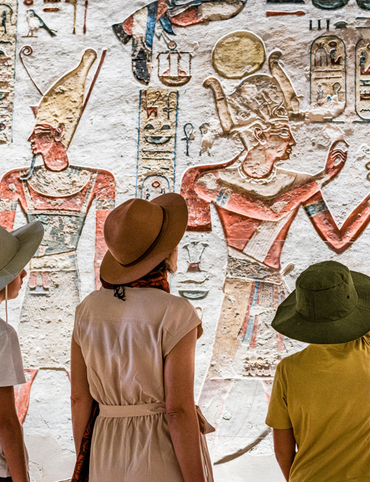

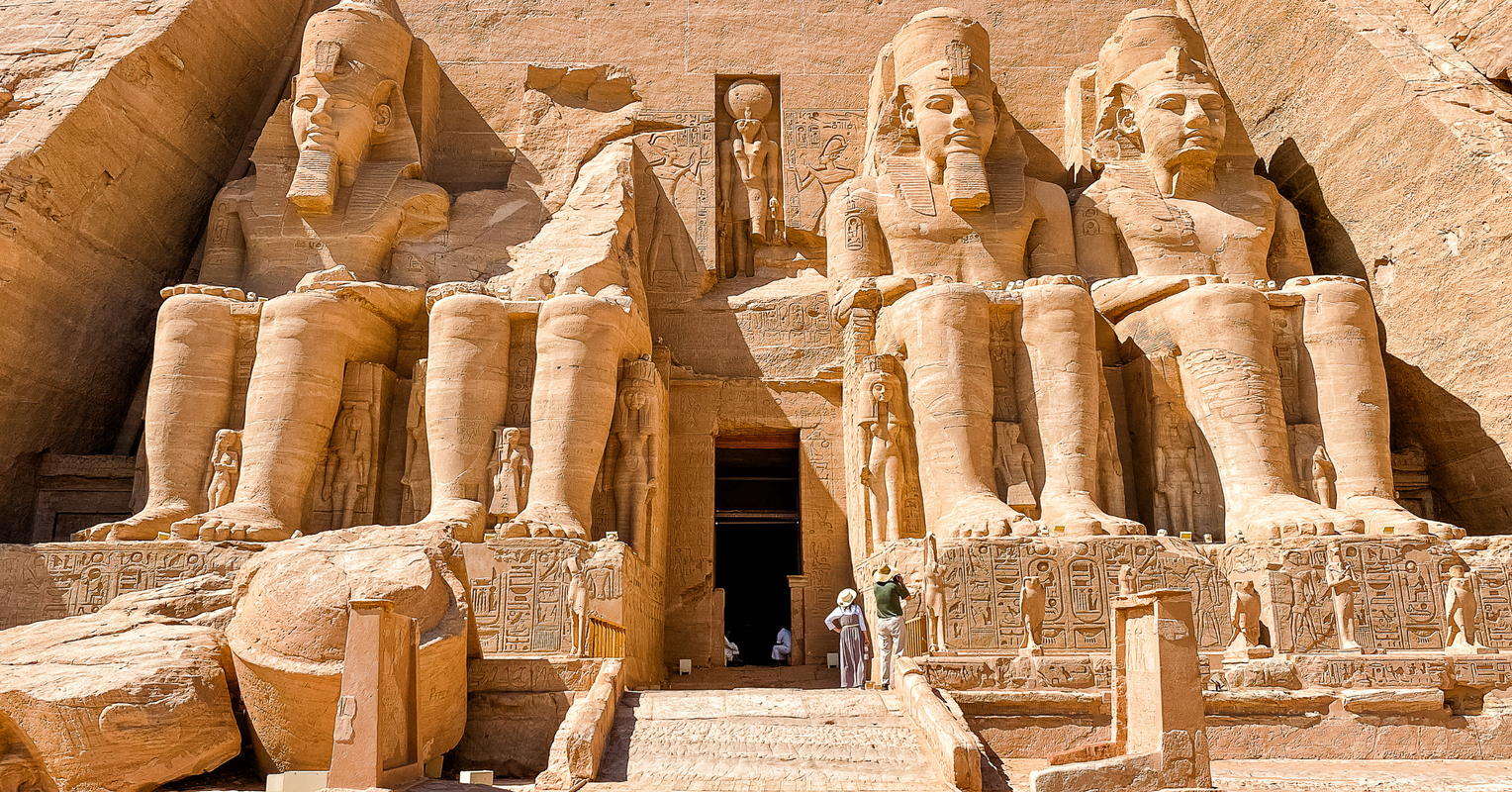
Middle East
11 days
10 nights
14 people
Moderate
History & Culture

Follow in the footsteps of gods, pharaohs and explorers as you take a deep dive into the many treasures of ancient Egypt. This unforgettable adventure will feature an all-star cast of magnificent monuments, mysterious temples, and memorable local cuisine. Feel the spirit of the enigmatic civilization that once walked this storied land, as you cross dream-like desert landscapes, cruise down the mighty Nile, and decipher the secrets of ancient pyramids and hidden tombs.
Special Access: During our visit to Cairo's Khan al-Khalili Bazaar, meet a goldsmith who takes us into his workshop and talks to us about the trade. Access to the workshop is usually not allowed, but we get behind the scenes access.
Travel with Purpose: Visit Manshiyat Nasser, a section of Cairo rarely visited by travelers and lacking in basic government services, to learn about the community's resiliency and creative collective-action solutions to challenges.
Looking for 2024 dates? Click here!
Or click here for a kid-friendly trip to Egypt!

Salām 'alaykum and welcome to Cairo! Your Atlas Obscura Guide will meet you at Cairo Airport and whisk you off via private transfer to your hotel in the heart of the city, where you will enjoy extraordinary views over the Nile. This evening, get to know your fellow intrepid travelers over dinner at a local restaurant that serves up authentic Egyptian cuisine.

Salām 'alaykum and welcome to Cairo! Your Atlas Obscura Guide will meet you at Cairo Airport and whisk you off via private transfer to your hotel in the heart of the city, where you will enjoy extraordinary views over the Nile. This evening, get to know your fellow intrepid travelers over dinner at a local restaurant that serves up authentic Egyptian cuisine.
Novotel Cairo El Borg or similar, Cairo
Welcome Dinner
Novotel Cairo El Borg or similar, Cairo
Welcome Dinner

Experience the splendor of ancient Egypt today as you explore its most famous treasures. Begin your journey at the Egyptian Museum, where you’ll stand face-to-face with the iconic Golden Mask of King Tut and wander amongst the ancient stone statues, sarcophagi and papyrus drawings that make up one of the world’s greatest classical museums. Then, decode the mysteries of one of the Seven Wonders of the World as you journey into the desert to witness the awe-inspiring sight of The Great Pyramids and the Sphinx.

Experience the splendor of ancient Egypt today as you explore its most famous treasures. Begin your journey at the Egyptian Museum, where you’ll stand face-to-face with the iconic Golden Mask of King Tut and wander amongst the ancient stone statues, sarcophagi and papyrus drawings that make up one of the world’s greatest classical museums. Then, decode the mysteries of one of the Seven Wonders of the World as you journey into the desert to witness the awe-inspiring sight of The Great Pyramids and the Sphinx.
Novotel Cairo El Borg or similar, Cairo
Breakfast
Novotel Cairo El Borg or similar, Cairo
Breakfast
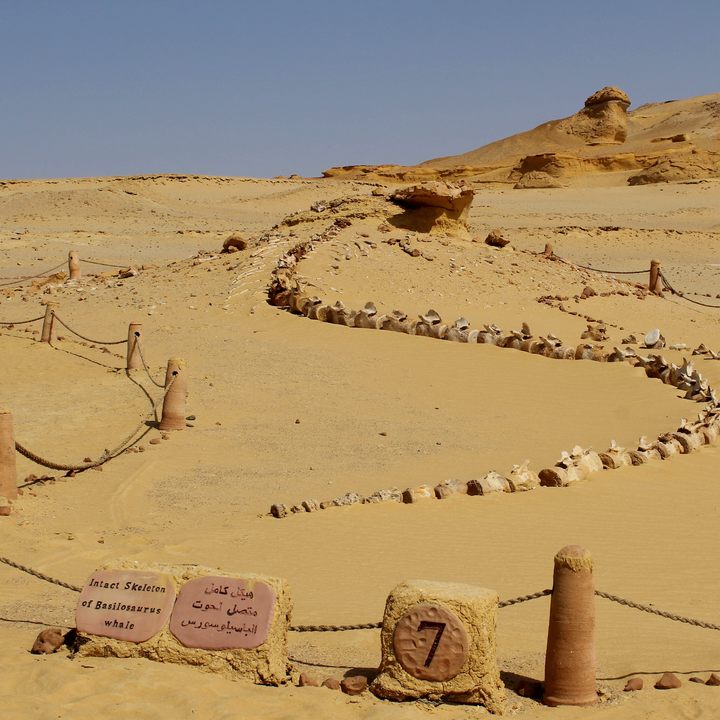
Travel across arid plains to the ancient oasis city of Al Fayoum, known as the “Garden of Egypt,” where towering date palms and sunflowers sway softly in the breeze as local farmers work the lush fields with their water buffalo. A thrilling ride across the sand dunes in a 4x4 desert safari vehicle will take you to Wadi al-Hitan, Egypt's "Whale Valley.” With an experienced archaeologist by your side, discover a treasure trove of whale fossils scattered amid the sand and rocks. Later, soak up the peace and tranquility of Wadi Rayan, a desert valley where the barren landscape is broken by picturesque lakes, stunning waterfalls, and tree-lined pools.

Travel across arid plains to the ancient oasis city of Al Fayoum, known as the “Garden of Egypt,” where towering date palms and sunflowers sway softly in the breeze as local farmers work the lush fields with their water buffalo. A thrilling ride across the sand dunes in a 4x4 desert safari vehicle will take you to Wadi al-Hitan, Egypt's "Whale Valley.” With an experienced archaeologist by your side, discover a treasure trove of whale fossils scattered amid the sand and rocks. Later, soak up the peace and tranquility of Wadi Rayan, a desert valley where the barren landscape is broken by picturesque lakes, stunning waterfalls, and tree-lined pools.
Tzila Lodge or similar, Fayoum
Breakfast, Dinner
Tzila Lodge or similar, Fayoum
Breakfast, Dinner
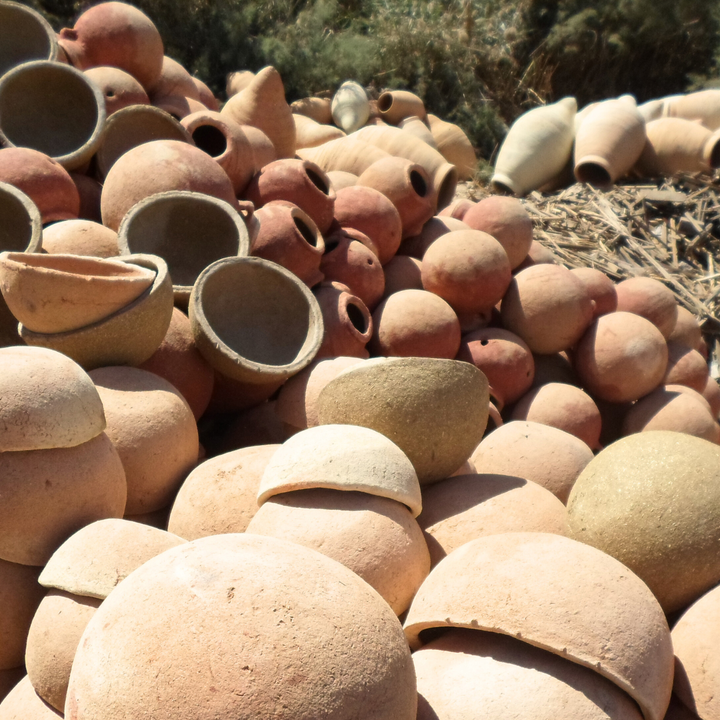
Embark on an adventure to Tunis Village, an idyllic oasis nestled on a hill with breathtaking views of a large saltwater lake. Discover the vibrant pottery and handicraft workshops that have flourished here since Swiss potter Evelyn Porret transformed the village in the 1980s. Explore the modern pottery school inspired by noted Egyptian architect Hassan Fathy’s designs, and take a wander and admire the serene beauty of the village. Enjoy a delicious lunch with stunning views before heading back to Cairo.

Embark on an adventure to Tunis Village, an idyllic oasis nestled on a hill with breathtaking views of a large saltwater lake. Discover the vibrant pottery and handicraft workshops that have flourished here since Swiss potter Evelyn Porret transformed the village in the 1980s. Explore the modern pottery school inspired by noted Egyptian architect Hassan Fathy’s designs, and take a wander and admire the serene beauty of the village. Enjoy a delicious lunch with stunning views before heading back to Cairo.
Novotel El Borg, Cairo or similar
Breakfast, Lunch
Novotel El Borg, Cairo or similar
Breakfast, Lunch
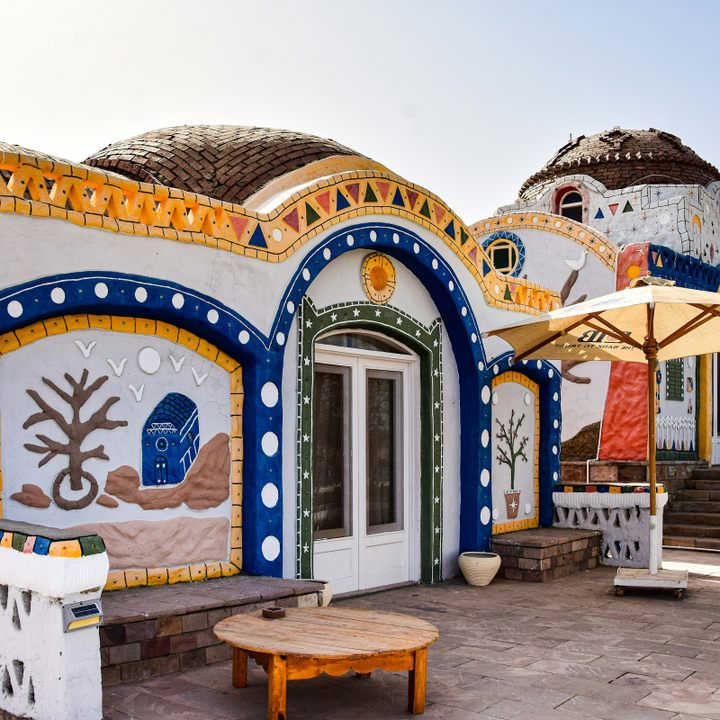
Fly to Aswan today to uncover the mystical wonders of Nubia. At the Nubian Museum, you’ll see over 3,000 Egyptian artifacts showcasing the region's ancient history. Next, unlock the secrets of the Nabata Playa Stone Circle, believed to be the world’s first astronomical site, predating Stonehenge by 2,000 years. Then hop on a motorboat to Philae Temple, an island sanctuary that was saved from rising Nile waters in the Aswan Dam in the 1970s and relocated to Agilkia Island. Later, experience modern Nubian culture with a visit to the home of a local family who will treat you to a memorable dinner and an insight into daily life. Enjoy an unforgettable evening of delicious Nubian dishes, warm hospitality, and traditional dancing.

Fly to Aswan today to uncover the mystical wonders of Nubia. At the Nubian Museum, you’ll see over 3,000 Egyptian artifacts showcasing the region's ancient history. Next, unlock the secrets of the Nabata Playa Stone Circle, believed to be the world’s first astronomical site, predating Stonehenge by 2,000 years. Then hop on a motorboat to Philae Temple, an island sanctuary that was saved from rising Nile waters in the Aswan Dam in the 1970s and relocated to Agilkia Island. Later, experience modern Nubian culture with a visit to the home of a local family who will treat you to a memorable dinner and an insight into daily life. Enjoy an unforgettable evening of delicious Nubian dishes, warm hospitality, and traditional dancing.
Basma Hotel or similar, Aswan
Breakfast, Dinner
Basma Hotel or similar, Aswan
Breakfast, Dinner
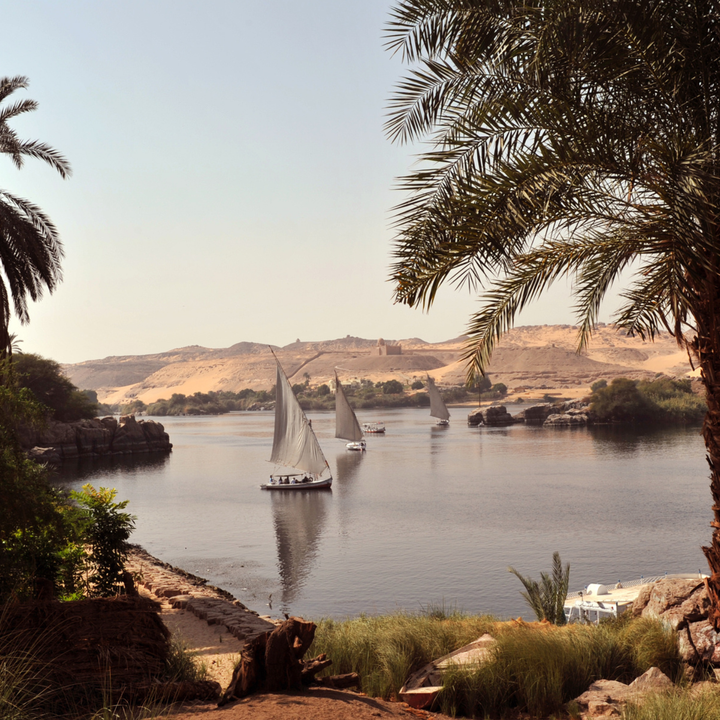
Catch a short flight to Abu Simbel, one of the crowning monuments of Rameses the Great and his favorite wife Queen Nefertari, completed in 1244 BCE, and still considered one of Egypt’s greatest treasures. Fun fact: UNESCO’s World Heritage Convention was formed specifically to preserve Abu Simbel. After the Nasser Dam was built, the temple was briefly submerged underwater. A large effort saw it removed and rebuilt, piece by piece in the late 1960s. Set sail along the Nile in a traditional Felucca (wooden boat) this afternoon and enjoy a delicious lunch onboard.

Catch a short flight to Abu Simbel, one of the crowning monuments of Rameses the Great and his favorite wife Queen Nefertari, completed in 1244 BCE, and still considered one of Egypt’s greatest treasures. Fun fact: UNESCO’s World Heritage Convention was formed specifically to preserve Abu Simbel. After the Nasser Dam was built, the temple was briefly submerged underwater. A large effort saw it removed and rebuilt, piece by piece in the late 1960s. Set sail along the Nile in a traditional Felucca (wooden boat) this afternoon and enjoy a delicious lunch onboard.
Basma Hotel or similar, Aswan
Breakfast, Lunch
Basma Hotel or similar, Aswan
Breakfast, Lunch

Buckle up for a scenic drive to Luxor, stopping by the mesmerizing Kom Ombo temple along the way. This ancient ruin, perched on the river's edge, offers a captivating insight into the Greco-Roman period. Built in 181BC, it’s dedicated to Horus the God of protection and Sobek the fertility god. Don’t miss the mummified crocodiles, which are now displayed in the Crocodile Museum attached to the temple. After checking in to your Luxor hotel, head to the East Bank for an unforgettable guided tour of Karnak Temple, a renowned UNESCO World Heritage Site. This legendary complex, the largest religious site ever constructed for the god Amun-Ra, was built over an astonishing 2,000 years and is a true marvel of ancient architecture.

Buckle up for a scenic drive to Luxor, stopping by the mesmerizing Kom Ombo temple along the way. This ancient ruin, perched on the river's edge, offers a captivating insight into the Greco-Roman period. Built in 181BC, it’s dedicated to Horus the God of protection and Sobek the fertility god. Don’t miss the mummified crocodiles, which are now displayed in the Crocodile Museum attached to the temple. After checking in to your Luxor hotel, head to the East Bank for an unforgettable guided tour of Karnak Temple, a renowned UNESCO World Heritage Site. This legendary complex, the largest religious site ever constructed for the god Amun-Ra, was built over an astonishing 2,000 years and is a true marvel of ancient architecture.
Iberotel Hotel or similar, Luxor
Breakfast
Iberotel Hotel or similar, Luxor
Breakfast
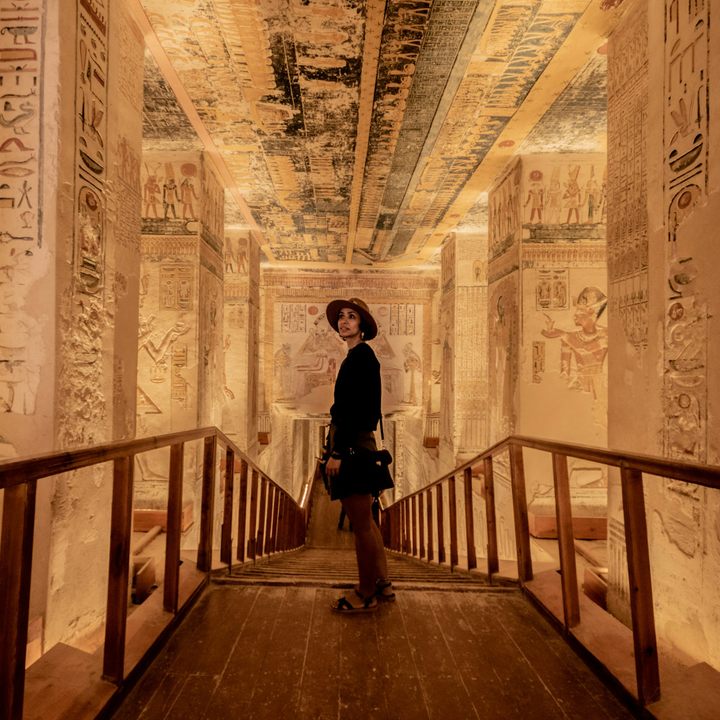
Visit Pharaoh Hatshepsut’s mortuary temple today, considered to be a masterpiece of ancient Egyptian architecture. See the Colossi of Memnon, ancient statues that have captivated the imaginations of curious travelers for millennia. Join a local family for lunch to try some tasty traditional home cooking. Shortly before sunset, you'll venture into the famed Valley of the Kings, the site of royal burials since 2100 BCE, for an exclusive private encounter and once in a lifetime experience. Arriving shortly before it closes to the public, enter the tomb of King Tutankhamun where you can view his mummy. Once everyone else has departed, explore this sprawling and spectacular place where discoveries are still being made.

Visit Pharaoh Hatshepsut’s mortuary temple today, considered to be a masterpiece of ancient Egyptian architecture. See the Colossi of Memnon, ancient statues that have captivated the imaginations of curious travelers for millennia. Join a local family for lunch to try some tasty traditional home cooking. Shortly before sunset, you'll venture into the famed Valley of the Kings, the site of royal burials since 2100 BCE, for an exclusive private encounter and once in a lifetime experience. Arriving shortly before it closes to the public, enter the tomb of King Tutankhamun where you can view his mummy. Once everyone else has departed, explore this sprawling and spectacular place where discoveries are still being made.
Iberotel Hotel or similar, Luxor
Breakfast, Lunch
Iberotel Hotel or similar, Luxor
Breakfast, Lunch
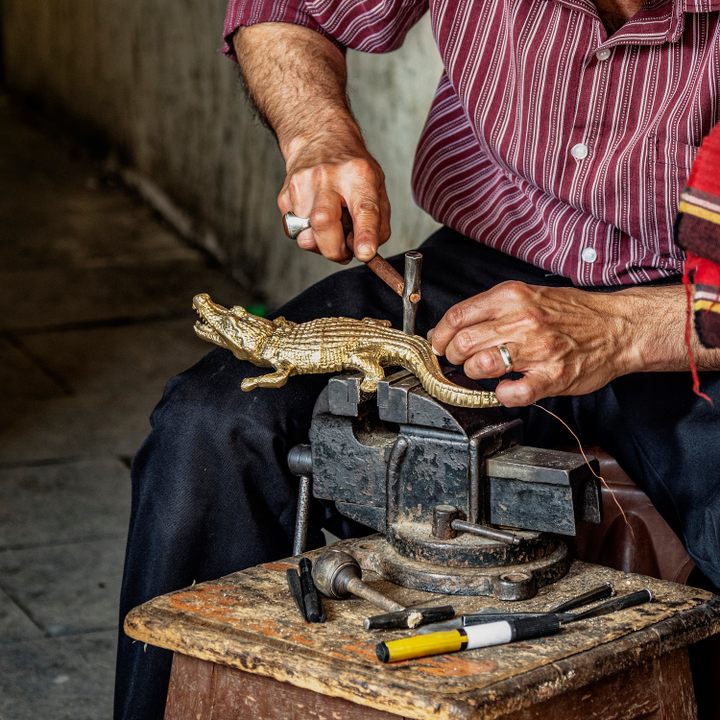
Dive into Coptic Cairo today, the ancient stronghold of Christianity in Egypt. Enjoy visits to the Hanging Church and the historic Ben Ezra Synagogue, which according to local folklore sits on the site where baby Moses was found. Next, embark on a walking tour through Islamic Cairo and immerse yourself in the vibrant Khan al-Khalili Bazaar, one of the world’s oldest markets. This enchanting outdoor emporium of treasures is an absolute must-see, bursting with colors and rich aromas. Learn how food vendors prepare popular local dishes, explore the Al Attarin spice and El Sagha gold markets, savor tea at the iconic Feshawi Café, and enjoy an exclusive behind-the-scenes experience with a local goldsmith who will teach you some of the tricks of his trade.

Dive into Coptic Cairo today, the ancient stronghold of Christianity in Egypt. Enjoy visits to the Hanging Church and the historic Ben Ezra Synagogue, which according to local folklore sits on the site where baby Moses was found. Next, embark on a walking tour through Islamic Cairo and immerse yourself in the vibrant Khan al-Khalili Bazaar, one of the world’s oldest markets. This enchanting outdoor emporium of treasures is an absolute must-see, bursting with colors and rich aromas. Learn how food vendors prepare popular local dishes, explore the Al Attarin spice and El Sagha gold markets, savor tea at the iconic Feshawi Café, and enjoy an exclusive behind-the-scenes experience with a local goldsmith who will teach you some of the tricks of his trade.
Novotel El Borg or similar, Cairo
Breakfast
Novotel El Borg or similar, Cairo
Breakfast
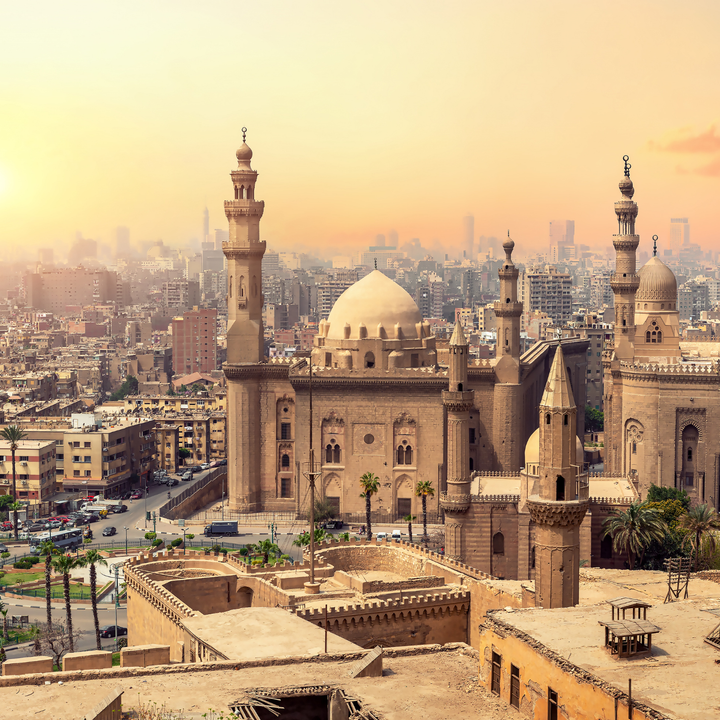
Explore the lavish Manial Palace, home to Prince Mohamed Ali, and admire its magnificent historic displays. Next, step into the majestic Mosque and Madrasa of Sultan Hassan, one of Cairo's most exquisite examples of early Mamluk architecture and a true gem of the Islamic world. Afterward, venture into Garbage City at Mokattam, a unique location where the Zabbaleen people have developed one of the world’s most efficient recycling hubs. Next, you’ll visit St. Simon Monastery, famously known as the Cave Church, for a one-of-a-kind experience. This evening, savor a delicious farewell dinner at a local restaurant, where you can reminisce with your fellow travellers about your amazing journey through Egypt.

Explore the lavish Manial Palace, home to Prince Mohamed Ali, and admire its magnificent historic displays. Next, step into the majestic Mosque and Madrasa of Sultan Hassan, one of Cairo's most exquisite examples of early Mamluk architecture and a true gem of the Islamic world. Afterward, venture into Garbage City at Mokattam, a unique location where the Zabbaleen people have developed one of the world’s most efficient recycling hubs. Next, you’ll visit St. Simon Monastery, famously known as the Cave Church, for a one-of-a-kind experience. This evening, savor a delicious farewell dinner at a local restaurant, where you can reminisce with your fellow travellers about your amazing journey through Egypt.
Novotel El Borg or similar, Cairo
Breakfast, Dinner
Novotel El Borg or similar, Cairo
Breakfast, Dinner
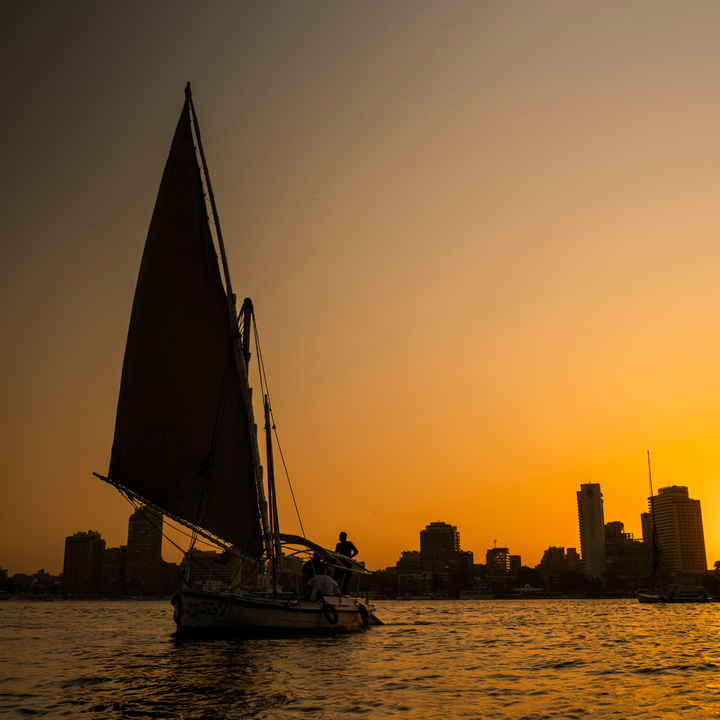
After your unforgettable journey through some of the world’s most storied lands, it’s time to say goodbye to the archaeological wonders and the friends we’ve met along the way. Head to the airport or on to your next destination. Until our next adventure!

After your unforgettable journey through some of the world’s most storied lands, it’s time to say goodbye to the archaeological wonders and the friends we’ve met along the way. Head to the airport or on to your next destination. Until our next adventure!
Breakfast
Breakfast
Deposit to book your trip: $250 USD.
Balance due 90 days prior to departure.
The listed price of the trip is per person based on double occupancy.
The below qualifies only for departures through May 1, 2024:
The listed price does not include the internal domestic flights from Cairo to Luxor and Aswan to Abu Simbel to Cairo. This flight is priced separately and will automatically be added to your booking and final balance. The economy class fare is $695 per person.
Deposit to book your trip: $250 USD.
Balance due 90 days prior to departure.
The listed price of the trip is per person based on double occupancy.
The below qualifies only for departures through May 1, 2024:
The listed price does not include the internal domestic flights from Cairo to Luxor and Aswan to Abu Simbel to Cairo. This flight is priced separately and will automatically be added to your booking and final balance. The economy class fare is $695 per person.
You’re in good company.
Opt for a Private Room to yourself, subject to availability, for a supplemental cost of $850 USD.
Solo travelers typically make up about half of our small groups. With curiosity at the center of our experiences, there’s a natural camaraderie that develops over the course of a trip.
If you don’t opt for a Private Room, you'll be matched with another solo traveler of the same gender.
You’re in good company.
Opt for a Private Room to yourself, subject to availability, for a supplemental cost of $850 USD.
Solo travelers typically make up about half of our small groups. With curiosity at the center of our experiences, there’s a natural camaraderie that develops over the course of a trip.
If you don’t opt for a Private Room, you'll be matched with another solo traveler of the same gender.
Cairo airport (CAI) connects to a range of flight hubs in North America. The best flight connections to Cairo are offered by EgyptAir and American Airlines.
*Airport transfers are only provided if arriving & departing on the trip dates, or if pre/post arrangements have been made through Atlas Obscura.
Cairo airport (CAI) connects to a range of flight hubs in North America. The best flight connections to Cairo are offered by EgyptAir and American Airlines.
*Airport transfers are only provided if arriving & departing on the trip dates, or if pre/post arrangements have been made through Atlas Obscura.
This tour has a moderate activity level. Consider four to six miles of walking each day, with lots of time spent moving around and on your feet. You should be comfortable walking on both flat and uneven ground, as well as stairs.
This tour has a moderate activity level. Consider four to six miles of walking each day, with lots of time spent moving around and on your feet. You should be comfortable walking on both flat and uneven ground, as well as stairs.
Check out the Essential Trip Information for this trip or our general FAQs.
Call us at +1 833-919-9154
Send us a
Have a question for us about Treasures of Egypt: Hidden Tombs, Ancient Pyramids & Old Cairo? We're here to help!
Call us at +1 833-919-9154
Check out our FAQ
This site is protected by reCAPTCHA and the Google Privacy Policy and Terms of Service apply.
Have a question for us about Treasures of Egypt: Hidden Tombs, Ancient Pyramids & Old Cairo? We're here to help!
Call us at +1 833-919-9154
Check out our FAQ
This site is protected by reCAPTCHA and the Google Privacy Policy and Terms of Service apply.
Sign up for our emails.
Have a question for us? We're here to help!
Call us at +1 833-919-9154
Check out our FAQ
This site is protected by reCAPTCHA and the Google Privacy Policy and Terms of Service apply.